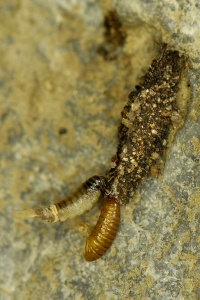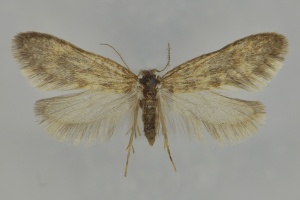EU ← ↑ →
 00832b Bankesia cephalonica WEIDLICH, 2016
00832b Bankesia cephalonica WEIDLICH, 2016
1, ♀, Paratypus: Griechenland, Ionische Inseln, Kefalonia, Nationalpark Enos-Gipfel, 1600 m, e.o. 25. Januar 2016 (leg., cult. & Foto: Michael Weidlich)
Diagnose
Männchen
1, ♂, Holotypus, Flügelspanne 13,0 mm: Griechenland, Ionische Inseln, Kefalonia, Nationalpark Enos-Gipfel, 1600 m, 2. Mai 2003 (leg. & Foto: Michael Weidlich)
Biologie
Habitat
1: Griechenland, Ionische Inseln, Kefalonia, Nationalpark Enos-Gipfel, 1600 m, 5. Mai 2015 (Foto: Michael Weidlich)
Weitere Informationen
Etymologie (Namenserklärung)
WEIDLICH (2016: 271): „Derivatio nominis: Die neue Art wird nach der Insel Kefalonia benannt, auf der sie offenbar endemisch vorkommt.“
Taxonomie
Die DNA-Sequenzierung eines männlichen Paratypen ergab nach WEIDLICH (2016: 272-273) Unterschiede von 6-7 % zu B. conspurcatella und 27 % zu B. montanella.
Typenmaterial
WEIDLICH (2016: 271): „Holotypus: ♂, 02.05.2003 (Flügelspanne 13,0 mm. Fig. 1): Europa meridionalis, Greece-West/Kefalonia, Ionische Inseln, Nationalpark Enos-Gipfel, 1600 m NN, leg. Dr. M. WEIDLICH. Er befindet sich in coll. Museum für Naturkunde des Leibniz Institutes in Berlin.“ — Paratypen: 31 ♂♂ und 28 ♀♀ (bei den gezüchteten Faltern jeweils mit Sack und Puppenhülle) sowie 293 Säcke „in den Sammlungen W. R. ARNSCHEID (Bochum/Deutschland), Naturkundemuseum der Leibniz Gesellschaft (Berlin/Deutschland), Tiroler Landesmuseen-Betriebsgesellschaft m.b.H. (Innsbruck/Österreich) und Z. TOKÁR (Michalovce/Slowakei). “.
Literatur
- Erstbeschreibung: WEIDLICH, M. (2016): Zur Schmetterlingsfauna der Ionischen Inseln Griechenlands mit der Beschreibung neuer Psychiden-Taxa sowie ein Beitrag zu ihrer Köcherfliegenfauna (Lepidoptera, Trichoptera). — Contributions to Entomology 66 (2): 265-320 [PDF auf zobodat.at].
Bestimmungshilfe / Schmetterlingsfamilien / Psychidae (Echte Sackträger)
EU ← ↑ →
 00832b Bankesia cephalonica WEIDLICH, 2016 non-d-ch-a
00832b Bankesia cephalonica WEIDLICH, 2016 non-d-ch-a


